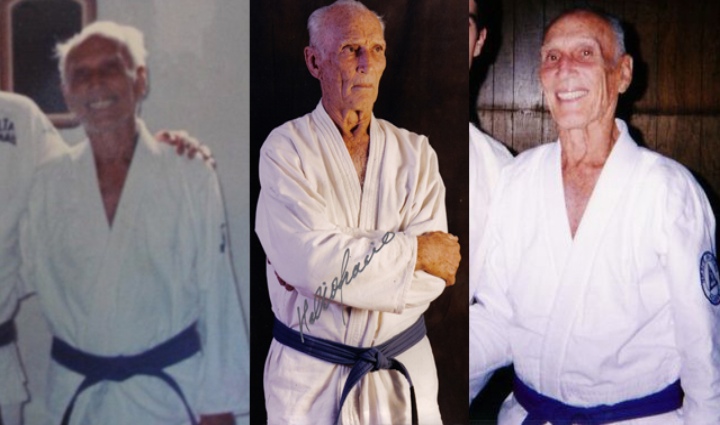The most common images of Grandmaster Helio Gracie are of him wearing a red belt with 10 degrees, which is reserved for the founders of Gracie/Brazilian Jiu-Jitsu (Carlos, Helio, George, Oswaldo Gracie). There are however a few pictures where the Grandmaster appears with a blue belt.
In a revealing video by Valente BrothersTV, Professor Pedro Valente delves into the intriguing story behind the navy belt in Brazilian Jiu-Jitsu, a symbol steeped in history and rebellion.
The Origins: A Mark of Rebellion and Preference
The story begins with Grandmaster Hélio Gracie, who, in his youth, chose to wear a navy belt. Valente quotes the Grandmaster’s straightforward rationale: “I like the color of that belt, and that’s the belt that I wear.” But it wasn’t just about preference. This choice symbolized an act of rebellion against the Judo Federation’s rules, as Hélio Gracie wanted to practice Jiu-Jitsu as a comprehensive fighting system.
Transition to the Red Belt and Return to Navy
As the Jiu-Jitsu Federation established belt colors, Grandmaster Hélio adopted the red belt. However, he eventually reverted to the navy belt as a form of protest. Valente recalls, “As soon as he had a chance, as a protest, he went back to his original blue belt.”
Honoring the Legacy
To honor Grandmaster Hélio, UFC champion Royce Gracie, suggested by Valente Brothers’ father, began wearing the navy belt. Valente and his brothers followed suit, adopting the navy belt to pay tribute to their Grandmaster.
Introducing the Navy Bar in Belt Design
Extending this homage to their students, Valente Brothers introduced a unique element: instead of a black bar on the belts, they used a navy bar. Pedro Valente explains, “We wanted our students to also pay tribute to our Grandmaster, and so… instead of them wearing the black bar on their belts, they began to wear the Navy bar.” This modification also applies to black belts, who, after a period with a white bar, transition to a navy bar with white borders.
The Significance of White and Blue
The combination of white and blue has long been significant in Jiu-Jitsu, primarily due to the traditional white kimono paired with a blue belt. The Valente Brothers were initially skeptical about combining the black belt with the navy bar but were inspired by a Brazilian soccer team, Grêmio, known for their blue and black uniforms.
The Navy Bar: A Symbol of Respect and Heritage
Ultimately, the introduction of the navy bar on black belts signifies respect for their heritage and tradition. Pedro Valente expresses pride in this innovation, “We’re very happy that we were able to introduce this navy bar concept in Jiu-Jitsu as a tribute to Grandmasters Carlos and Hélio Gracie.”
In conclusion, the navy belt in Brazilian Jiu-Jitsu is more than just a colored fabric; it represents a rich history of rebellion, respect for tradition, and a continuous tribute to the legacy of the Grandmasters of the sport. Through these colors, practitioners not only honor their past but also carry a piece of Jiu-Jitsu history with them.


















